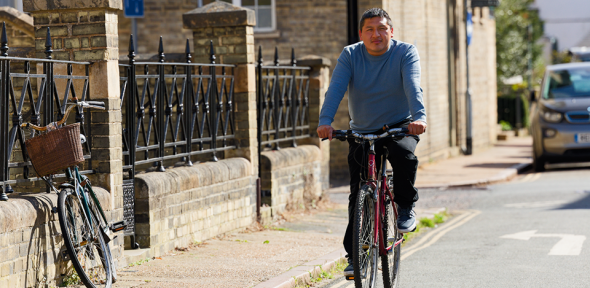
Lautaro Acosta on Panton Street, taken by Michael Webb ©University of Cambridge
Dr Lautaro Nicolás Acosta is a Visiting Research Fellow from Argentina working with Prof. Dame Clare Grey’s Group for six months.
His home University is the Research and Development Center for Advanced Materials and Energy Storage of Jujuy, Argentina where he is a postdoc studying lithium-sulphur batteries under the supervision of Dr Alvaro Yamil Tesio. The Visiting Research Fellowship scheme is setup by the Faraday Institution and strengthens partnerships between the UK and the lithium triangle countries Argentina and Chile by supporting Early Career Battery Researchers. His PhD was in engineering so his expertise is a valuable addition to the Grey Group.
The Grey Group
Lithium-ion batteries contain two plates called cathode and anode, which release or accept lithium in a rocking chair mechanism, so that current can flow during charge and discharge across an electrolyte that is placed between the two plates. Lithium is hosted in a crystalline structure in the cathode side and in graphite in the anode side. Due to cycling conditions all these components can be exposed to a continuous degradation mechanism, as particle cracking, gas evolution or transition metal dissolution decreases the performance of the battery.
In the Grey Group, Lautaro is using specially designed cells that allow him to study the electrochemical processes that happen in the cathode and see how its performance changes as it charges and discharges over hundreds of cycles. The material starts out pristine so any defects that appear are as a result of the charging cycle. These results will inform research into battery material stability with the potential to develop longer-lasting batteries.
Cambridge
Lautaro wanted to experience research around the globe and the Faraday Institution programme was the perfect opportunity. “My experience with the Faraday Institution has been great, the laboratory setting is fantastic. The facilities and workshop enable research to answer niche questions.”
While at the Department, Lautaro has been able to collaborate with Clare Grey and other members of the Group and while continuing his collaborations in Argentina. Outside the laboratory, Lautaro is enjoying Cambridge’s cycling lifestyle and the beautiful landscapes that the city has to offer.
“Alongside the laboratories I will remember the weather, though not in such a good way!”
Early engineer
Lautaro’s father was a car mechanic so, as a child, Lautaro watched him pull cars apart, put them back together and make them work again. “I was obsessed with how things worked and I would take things apart too to try and put them back together. Growing up around my dad and his workshop definitely made me want to study engineering.”
Lautaro ended up fulfilling this dream studying his engineering degree at the at National University of Jujuy, then his PhD at the National University of Salta.
“Argentina has a history with nuclear energy. We have three nuclear powerplants in the country now, so when I started University I was interested in studying nuclear engineering. For my PhD, I studied alternate energy sources to nuclear energy looking at the isotopic separation of lithium and this quite naturally led to my study of lithium use in batteries.”
Batteries for sustainability
Batteries are an essential step towards reducing our reliance on fossil fuels and carbon-emissions. Lautaro explains: “We need batteries to make clean-energy sources consistent and reliable. Because of the intermittent nature of some green renewable energy, we need batteries to store backup energy and also for a transition to an electric vehicle fleet.”
After his visit, he will return to his postdoc in Jujuy and continue his research into higher energy density batteries that are more efficient and last longer.
This article was originally published in Chem@Cam magazine Issue 70.
